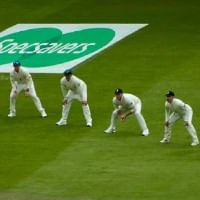One of the biggest talking points from the opening day of the Border-Gavaskar Trophy 2024-25, which may set the tone for the series in more ways than one, was KL Rahul's dismissal after a contentious call. Mitchell Starc dismissed the opener towards the end of the first session after he had worked hard to survive against the new ball.
The batter toiled hard for 74 deliveries, choosing his strokes carefully and leaving the ball with the utmost precision. His presence at the crease was pivotal as the rest of the top order had failed to create an impression after opting to bat first.
On that note, let us reflect on the incident, which is shrouded in a swamp of gray area.
Dissecting the incident in question
Attempting another one of his patented leaves, with his bat behind the pat, Rahul was a tad late on the occasion against Starc in the 23rd over. The Australians were encouraged by a faint sound, particularly the contingent behind the stumps. A late call to send the on-field call of not out upstairs brought the third umpire into play.
In what was expected to be a regulation call turned out to be a complicated one, because there was contact between the bat and pad which might interfere with the ultra-edge.
Sure enough, there was a spike when the ball passed the bat, but there was uncertainty behind the origin of the spike. An angle from behind the stumps showed the slightest deflection, but it was questionable as to whether it was something definitive or not.
The next catch comes in the form of the unavailability of the side-on angle, which could have put the entire debate to rest. Through that particular angle, it would have been easier to determine the 'timing of the spike'. The chances of both contacts being simultaneous were slim because if that was the case, the intensity of the spike would have been much greater.
Trapped in the gray area, with only an unconvincing camera angle that shows a dodgy deflection as good as an optical illusion, and a slight spike on the snicko, third umpire Richard Illingworth had two choices. Either label the available evidence as inconclusive, and ask the on-field umpire to stick with the original not-out decision, or trust the visual evidence of the deflection, and classify it as enough and conclusive to overturn the on-field decision. He went with the latter.
KL Rahul was visibly upset with the decision, and had a word with the umpires while walking off.
What does the rule book say?
As far as the protocol is concerned, the rule book dictates that if the third umpire does not find enough evidence, and is unable to come to a definitive decision with the available technology (in this case limited angles), then the on-field call will prevail.
However, this ranges from umpire to umpire, as to what they deem as enough evidence. In this case, Richard Illingworth felt that the deflection and the spike were enough for the decision to be overturned. On another day, this might not prove to be enough.
More importantly, they are not to draw any probable conclusion or convey something that they are unsure of.
Sections 3.3.6 and 3.3.7 of Appendix D of the playing conditions of the World Test Championship dictate that:
"If despite the available technology, the third umpire is unable to decide with a high degree of confidence whether the original on-field decision should be changed, then he/she shall report that the replays are ‘inconclusive’, and that the on-field decision shall stand. The third umpire shall not give answers conveying likelihoods or probabilities."
"In circumstances where the television technology (all or parts thereof) is not available to the third umpire or fails for whatever reason, the third umpire shall advise the on-field umpire of this fact but still provide any relevant factual information that may be ascertained from the available television replays and other technology."
Now as to why there was not enough evidence for the umpire to asses, boils down to the technology set up in Australia. The lack of the desired angle, which is usually not that hard to procure around the world, is because Australia uses Virtual Eye technology instead of Hawk-Eye technology.
The latter is the one used predominantly in world cricket, and its principle involves multiple high-speed cameras. Although Virtual Eye also uses a similar model, there is a difference in the way the result is produced.
In the end, everything boils down to the concept of conclusive evidence, and it is a subjective concept, differently perceived by each match official and umpire. Some do not need much evidence to conclude to overturn the original call, while others prefer to stay on the safe side, and assess all potential possibilities before delivering the verdict. What might be conclusive evidence for one match official might not be the case for another, and vice versa.
As a result, there is not much against the DRS protocol here, at least not more than personnel (human error) and the constricted technology in place.
Follow IPL Auction 2025 Live Updates, News & Biddings at Sportskeeda. Get the fastest updates on Mega-Auction and cricket news
